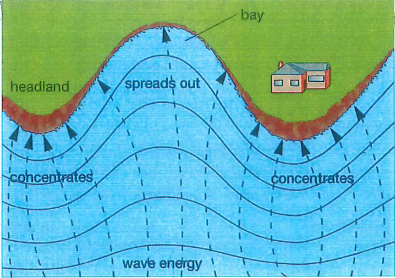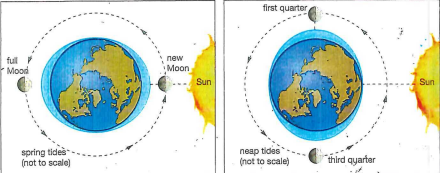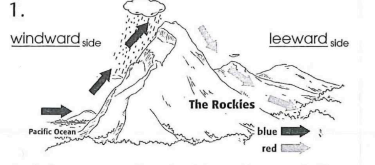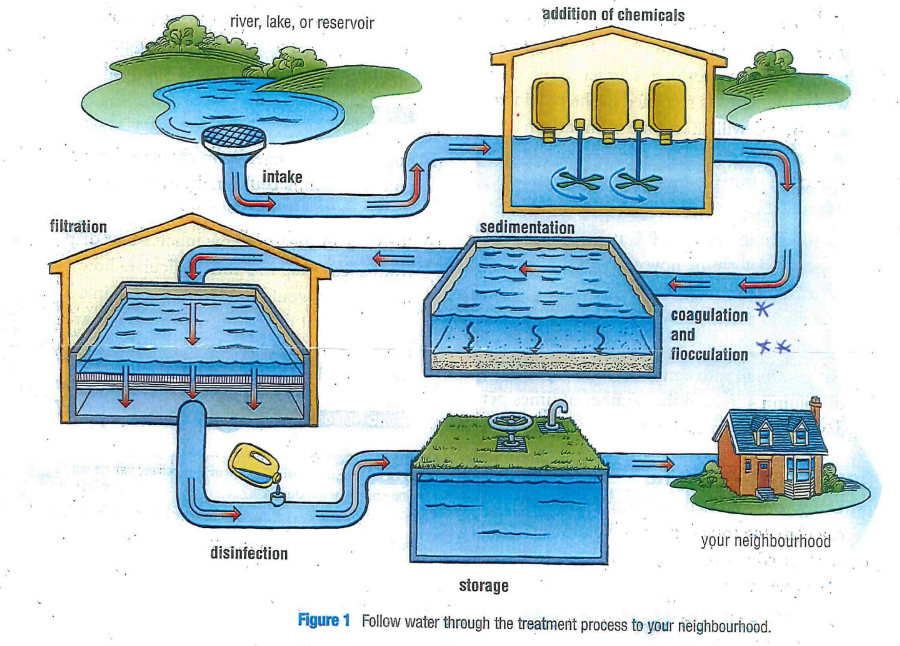Water Systems Quiz #2
Topics
Motion of the Ocean
Weather and Climate
Water Treatment
Contaminated Water
Motion of the Ocean
Waves
What is a wave?
A wave is a large ripple, set in motion by steady winds.
On what does a waves height depend?
A wave’s height depends on how fast, how long, and how far the wind blows over the water.
What are the properties of waves?
Some properties of waves include height (measured from the crest to the trough), wavelength (the distance from one crest to the next), and speed (the time required for one wave to pass a given point).
Why does a wave collapse when it reaches the shore?
A wave collapses when it reaches the shore because its crest has outrun its trough and topples forward. This is called a breaker.
How is water able to pass energy along?
Water passes energy along by moving water particles in a circular motion. As each particle moves, it bumps into the next particle and passes energy along.
Diagram

How many waves crash onto shore in a single day?
Approximately 14 000 waves crash into a shore in a single day.
Bays, Headlands, Erosion
What is a bay?
A bay is a part of the water that reaches into the land.
What is a headland?
A headland is a part of the land that sticks out into the water.
What is erosion?
Erosion is the process by which waves gradually wear away rocks on a beach.
Strech of Coastline Diagram

Tides
Spring Tide & Neap Tide

What is the difference between a spring tide and a neap tide?
Spring tides are the largest tidal movements and occur when the Earth, Sun, and Moon are in a line. Neap tides are the smallest tidal movements and occur when the Sun and Moon are at right angles to each other.
What does tidal range mean?
Tidal range means the difference between a high tide and a low tide.
How does gravity affect tides?
Tidal movements result mainly from the pull of the Moon’s gravity on the ocean. In spring tides, the Sun’s gravitational pull is added to the Moon’s. During neap tides, the Sun’s pull works against the Moon’s.
Terrific Tides
1. This object’s pull shifts water from one side of the ocean to the other: _____________
the Moon.
2. This is how many times a day tides rise and fall:__________________________________
2
3. This is a bay in Canada that is world famous for its tides: _________________________
the Bay of Fundy
4. These lands of tides occur on the side of Earth closest to the Moon and on the side farthest away: ___________
high tides
5. These bodies of water also have tides, but the change in water level is usually too small to be noticeable: _________
lakes
El Niño vs Ice Ages
El Nino
short-term warming of climate
caused by change in water currents in Pacific Ocean
warm water is blown eastward
disrupts normal weather patterns
winds pushed off usual paths
milder winters in Canada and northern U.S.
south-eastern U.S. gets more precipitation
Australia and Africa experience droughts
change in temperature on coast of Peru by 7 degrees
some marine animals move farther north
some plants and animals die in warmer waters
Ice Ages
long-term change in Earth’s climate
happened over the last three million years
at least four ice ages
most recent began 120 '000 years ago and ended 11 000 years ago
air temperatures about 5 degrees lower than now
buildup of snow in winter doesn’t melt in summer
snow piles to 1 km or higher
weight of snow turns lower layers to ice
Interactions Under the Sea
The arrows point to the animal doing the eating. Some examples of food chains in the ocean are:
plankton -sea urchin - octopus
kelp - fish - sea lion - shark
sea urchin - sea otter - shark
*Some people may include humans at the top of the food chain
Fishing for Life on the Sea Floor
1. A population explosion of algae is called an________________ .
algal bloom.
2. Certain bacteria use this process to produce food from chemicals._________
chemosynthesis.
3. Cracks in the ocean floor are called ___________ ,.
sea-floor vents.
4. The Grand Banks were reported by (last name)__________ .
Cabot.
5. The Grand Banks were a major fishing ground for the capture of these three types of fish:_________ ,_________ , and________ .
cod, haddock, and herring.
6. Some bacteria use ______ such as sulfur compounds, to produce food.
chemicals
7. The waters of the Labrador Current are _______ ; the waters of the Gulf Stream are______.
cold, warm
8. _________ and changes in water temperature or nutrient levels are possible causes of the decline in fish populations in the Grand Banks.
overfishing
9. Toxic chemicals can enter a food_______ and create health hazards.
chain
10. Where the Labrador Current and the Gulf Stream meet, there are good conditions for________ , on which the larger fish depend for food.
plankton
11. The arrival of new_______ _ of plants or animals can dramatically alter a natural ecosystem.
species
Weather and Climate
Weather and Climate
Weather
environmental conditions that change from day to day, such as the temperature, precipitation, and whether it is sunny or cloudy.
How does an ocean affect weather conditions?
It moderates (brings 2 extremes closer together) extreme temperature.
Climate
the average of weather conditions over a period of at least 30 years.
Calculating Average Temperature
Highest Temp - Lowest Temp = Average Temp
Water and Climate
Heat Sinks
Anything that is able to absorb thermal(heat) energy without becoming significantly warmer is called a heat sink. Water is an example of a heat sink. Oceans are constantly moving and mixing cool water and warm water heated by the sun. Oceans absorb a lot of heat from the sun, yet their temperature remains fairly constant and they do not evaporate.
Costal Community’s
You can tell if a community is costal because the 2 extremes are moderated.
Water Systems and Climate
Latitude
Imaginary horizontal line that indicates the distance from the equator
Topography
features of a landscape
Factors Affecting Air Temperature
While water heats up and cools down at a slower rate than land, water holds onto its absorbed heat longer than land
large bodies of water
prevailing winds
topography
latitude
Continental Climate:
Extreme temperatures e.g. Winnipeg, Manitoba
Marine Climate:
Mild temperatures e.g. Prince Rupert, BC
Prevailing Winds
The prevailing winds — winds that blow most frequently across a region — in Canada are westerly winds. They are winds that blow from the west. A westerly wind from the Pacific Ocean is laden with moisture when it reaches the west coast of Canada. It is forced to rise on the windward side (the side of a mountain facing the wind) of the Canadian Rockies, and moisture in the wind is lost through precipitation. The wind then descends on the other side (the leeward side) of the Rockies and becomes dry and warm. This wind is known as a Chinook, and can bring to places east of the Rockies what seems like a summer day even in the middle of winter.

Chinook
It is a westerly wind that descends the leeward side of the Rockies and brings warm and dry weather to places east of the Rockies.
The Rockies
The moist wind from the Pacific Ocean is forced to rise and rain on the western side of the Rockies, and it becomes dry and warm when it goes down the eastern side.
Water Treatment
Water Treatment Process
Water Treatment
Water treatment is the process of improving water quality by removing pollutants.
Process
Water must be pumped from a lake, river, or stream and moved to a treatment facility
Coagulants such as magnets are used to cause dirt particles to stick together. These waste clumps are called flocculation (floe).
The floe settles to the bottom of the tank and the remaining water moves through a filtration device.
Chlorine or ozone is added to the water to kill any harmful bacteria in the water.
The purified water is stored in a container and is ready to be used.
Flock
What is flock? Why is it important to the water treatment process?
A floc is a clump of waste. Coagulants such as magnets are used to cause dirt particles to stick together to make floc. Making floc is important because it allows the dirty sediment to be separated from the rest of the water.

Summary

Water Treatment and Disposal
What are the 2 main types of sewer and how do they differ?
Storm Sewers - gather rainwater or melted snow from streets
Sanitary Sewers - gather waste water from your home. In some areas, both sewer systems will connect and carry waste water to the water treatment plant. In other areas, storm sewers drain into local rivers, ponds or lakes.
Describe what the role microorganisms play in water treatment
Microorganisms are used to break down some organic material, like bacteria. Chlorine is then used in municipal water to remove (kill) these microorganisms.
Why should chemicals never be dumped down household or street drains?
Chemicals should never be dumped down drains as they may not be cleaned/removed before being returned into the water system. Although they may be diluted, they are never completely removed.
Predict what the consequence might be if water was not properly treated before or after use in homes.
Untreated water can result in illness or even death. Untreated water may also cause damage to water pipes or fixtures (toilet, sink, shower etc) leading to expensive repairs.
Well Water vs Municipal Water
Advantages | Disadvantages | |
|---|---|---|
Well Water (Rural Areas) | ● Free ● Natural (chemical free) | ● Cost to maintain/repair ● Potential contamination ● Testing of water quality necessary ● Potential for drying out due to drought |
Municipal Water (Urban Areas) | ● Unlimited source ● No cost to maintain/repair ● No testing required | ● Cost ● Potential for contamination (Walkerton, Ontario in 2000) ● Potential disruption in service |
Contaminated Water
How does water get contaminated?
Salt
natural geology of the bedrock
road salt
Nitrates
fertilizers
runoff from farmers’ fields
septic tanks
E .coli
animal waste
septic tanks
Chlorine
to kill bacteria and micro-organisms
Oil
nearby gas stations
dump sites